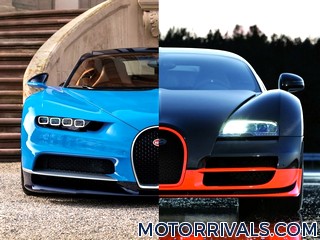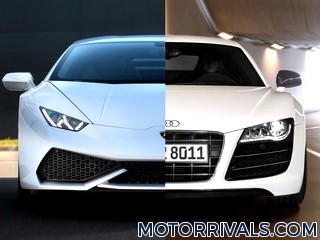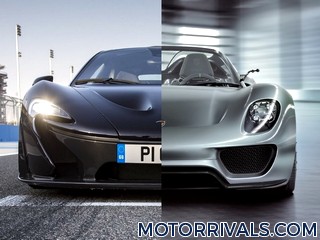2016 Ferrari LaFerrari vs 2016 McLaren P1
Ferrari LaFerrari Press Release Highlights
The wraps are finally off the “LaFerrari”. The Prancing Horse’s
eagerly-anticipated limited-series special, of which just 499 will be
built, made its world debut today at the Geneva International Motor
Show.
“We chose to call this model “LaFerrari”,” declared Ferrari’s President, Luca di Montezemolo, “because it is the maximum expression of what defines our company – excellence. Excellence in terms of technological innovation, performance, visionary styling and the sheer thrill of driving. Aimed at our collectors, this is a truly extraordinary car which encompasses advanced solutions that, in the future, will find their way onto the rest of the range, and it represents the benchmark for the entire automotive industry. “LaFerrari” is the finest expression of our company’s unique, unparalleled engineering and design know-how, including that acquired in Formula 1.”
For Ferrari the development of a limited-series special like the “LaFerrari” represents an opportunity to experiment with all the technological solutions that will later filter down onto the production cars. Of particular significance in this context is the introduction of the hybrid system which, making full use of the Scuderia Ferrari’s F1 KERS know-how, has resulted in a solution that exalts Ferrari’s fundamental values – performance and driving thrills. The hybrid technology used, known as HY-KERS, represents the perfect combination of maximum performance and lower emissions (just 330 g/km of CO2.)
The “LaFerrari” is equipped with dynamic controls that are integrated for the first time ever on a Ferrari road car with active aerodynamics and the HY-KERS system. A very advanced and uncompromising approach was also taken with the interior design which features an HMI inspired by F1 single-seaters.
“LaFerrari”, the eagerly awaited new model in the limited edition series from the Prancing Horse – of which only 499 examples will be built and more than twice the number of requests has already been received – is still the undisputed start at the Geneva Car Show on the second day, the show is open to the public.
963 bhp for the first hybrid in the history of the Prancing Horse with an absolute record performance: from 0 to 100 km/h in less than 3 seconds and from 0 to 200 km/h in less than 7. Compared to the Enzo the “LaFerrari” consumes less while the Co2 emission has been lowered by 50%.
The new car is a synthesis of the brand’s values, just like Chairman Luca di Montezemolo said during the presentation of the “LaFerrari”. “It is the highest expression of excellence of our company: technological innovation, performance, futuristic style, driving pleasure. It is an extraordinary car, destined to our collectors. A car with technical solutions, which in the future will be integrated in our range and which are the benchmark for the entire sector. “LaFerrari” represents the best planning and building capacities in our Company, including those acquired in Formula One, knowledge, unique in the world.”
“We chose to call this model “LaFerrari”,” declared Ferrari’s President, Luca di Montezemolo, “because it is the maximum expression of what defines our company – excellence. Excellence in terms of technological innovation, performance, visionary styling and the sheer thrill of driving. Aimed at our collectors, this is a truly extraordinary car which encompasses advanced solutions that, in the future, will find their way onto the rest of the range, and it represents the benchmark for the entire automotive industry. “LaFerrari” is the finest expression of our company’s unique, unparalleled engineering and design know-how, including that acquired in Formula 1.”
For Ferrari the development of a limited-series special like the “LaFerrari” represents an opportunity to experiment with all the technological solutions that will later filter down onto the production cars. Of particular significance in this context is the introduction of the hybrid system which, making full use of the Scuderia Ferrari’s F1 KERS know-how, has resulted in a solution that exalts Ferrari’s fundamental values – performance and driving thrills. The hybrid technology used, known as HY-KERS, represents the perfect combination of maximum performance and lower emissions (just 330 g/km of CO2.)
The “LaFerrari” is equipped with dynamic controls that are integrated for the first time ever on a Ferrari road car with active aerodynamics and the HY-KERS system. A very advanced and uncompromising approach was also taken with the interior design which features an HMI inspired by F1 single-seaters.
“LaFerrari”, the eagerly awaited new model in the limited edition series from the Prancing Horse – of which only 499 examples will be built and more than twice the number of requests has already been received – is still the undisputed start at the Geneva Car Show on the second day, the show is open to the public.
963 bhp for the first hybrid in the history of the Prancing Horse with an absolute record performance: from 0 to 100 km/h in less than 3 seconds and from 0 to 200 km/h in less than 7. Compared to the Enzo the “LaFerrari” consumes less while the Co2 emission has been lowered by 50%.
The new car is a synthesis of the brand’s values, just like Chairman Luca di Montezemolo said during the presentation of the “LaFerrari”. “It is the highest expression of excellence of our company: technological innovation, performance, futuristic style, driving pleasure. It is an extraordinary car, destined to our collectors. A car with technical solutions, which in the future will be integrated in our range and which are the benchmark for the entire sector. “LaFerrari” represents the best planning and building capacities in our Company, including those acquired in Formula One, knowledge, unique in the world.”
McLaren P1 Press Release Highlights
The astonishing new McLaren P1, which debuts in production form at the
Geneva Motor Show, has a clear goal – to be the best driver’s car in the
world on road and track. To achieve this objective, McLaren is using all
of its 50 years of racing experience and success, especially in the
fields of aerodynamics and lightweight carbon fibre technology.
The result is a car that has an unprecedented amount of downforce for a road vehicle: similar levels to a GT3 racing car and yet with even greater ground effect. This downforce not only boosts cornering and braking performance. It also helps balance, stability and driveability at all speeds.
The best driver’s car in the world must also have exceptional straight-line performance and instant throttle response. To deliver this, the McLaren P1 uses an innovative IPAS petrol-electric powertrain comprising a substantially revised 3.8-litre twin-turbo V8 petrol engine, coupled to a single electric motor, collectively known as M838TQ. Combined power output is 916 PS (903 hp). As important as absolute power is the electric motor’s ability to provide instant torque, making the powertrain superbly responsive. It is also amazingly efficient. Carbon dioxide emissions are less than 200g/km, and it can cover more than 10 km in electric-only mode.
Top speed is electronically limited to 350 km/h (217 mph), with the 0-100 km/h standing start acceleration taking less than three seconds .The McLaren P1 will power from rest to 200 km/h in less than seven seconds, and on to 300 km/h in less than 17 seconds – a full five seconds quicker than the McLaren F1.
The astonishing technology developed for the McLaren P1 includes active aerodynamics and adjustable suspension – both now banned in Formula 1, due to being seen to give a performance advantage. Airflow is optimised around the body through the use of an active wing and underbody devices. The adjustable rear wing can extend from the bodywork by 120mm on road, up to 300mm on the race track, maximising the levels of downforce. The wing is directly inspired by Formula 1 design, with the intersection of the double element rear wing and design of the endplates being the same as that on the 2008 championship winning MP4-23.
In addition, the McLaren P1 also features adjustable ride height as part of the new hydro-pneumatic suspension. The revolutionary RaceActive Chassis Control (RCC) can lower the car by 50mm in Race mode, to produce ground effect aerodynamics. It also features adaptive spring rates, roll control, pitch control and damping, all providing a huge range of adjustment, making the McLaren P1 perfect for either road or track. In Race mode, the spring rates stiffen by 300 per cent, allowing the McLaren P1 to corner at more than 2g.
Formula 1-inspired technology permeates the McLaren P1. The revolutionary new carbon fibre MonoCage monocoque forms a complete structure incorporating the vehicle’s roof and its distinctive snorkel air intake - a styling feature inspired by the McLaren F1 road car.
McLaren is an acknowledged world leader in carbon technology. The material offers lightness, strength and rigidity – improving performance, safety, handling, agility, durability, efficiency and ride comfort. The body panels of the McLaren P1 are also made from lightweight yet strong carbon composite, with their complex shapes tuned for optimal aerodynamics.
The McLaren P1 was designed from the outset to prioritise aerodynamic performance – just like a Formula 1 car. As with a Formula 1 car, wind tunnel testing and CFD (computational fluid dynamics) aerodynamic modelling were used to optimise the aerodynamic flow, both to provide incredible levels of downforce and to cool the powertrain. The result is 600kg of downforce at well below maximum speed (257 km/h / 161 mph) in Race mode, which is considerably higher than most other high performance supercars, and more in line with the levels of downforce generated by a GT3 racing car. This downforce improves the car’s cornering ability, especially in high speed corners. Balance, agility and controllability are all outstanding.
Other areas of Formula 1 technology evident on the McLaren P1 include the revolutionary layered carbon ceramic brakes, developed for the road by McLaren’s Formula 1 partners Akebono. The highly efficient IPAS (Instant Power Assist System) is a development of KERS (Kinetic Energy Recovery System) used on Formula 1 cars, while DRS (Drag Reduction System) is also used on the McLaren P1, giving extra power and straight-line speed both at the touch of a button. Brake Steer – an outlawed Formula 1 technology – is also used on the McLaren P1. It improves cornering behaviour and cornering speed.
The IPAS petrol-electric powertrain also ties in with upcoming Formula 1 regulations. From next year (2014), Formula 1 cars will have hybrid power, including an electric mode for the pit lane.
The McLaren P1 name is also inspired by Formula 1. P1 refers to ‘first place’ or ‘position one’ – particularly fitting as McLaren has 182 Grand Prix victories and 155 pole positions to-date, in its 47-year Formula 1 history. There is also heritage in that name: the McLaren F1 was initially known internally within McLaren as Project 1, or P1.
Despite the huge performance, the McLaren P1 is also a refined and comfortable high-speed supercar. ‘It is designed to be driven to the racing circuit, with great levels of comfort and refinement,’ says McLaren P1 programme director, Paul Mackenzie. ‘And then to be used on the racing circuit, where it will offer an experience matched only by purpose-built race cars.’
The ownership experience with the McLaren P1 will be as special as the car itself, Greg Levine, McLaren Automotive Sales and Marketing Director explains: “Owners will become part of the McLaren family, if they aren’t already. To maintain exclusivity, we have closely monitored demand, and announced a production number of just 375 units – a figure that will ensure the McLaren P1 will remain a rarity and, if spotted on the road, an unforgettable sight.”
The result is a car that has an unprecedented amount of downforce for a road vehicle: similar levels to a GT3 racing car and yet with even greater ground effect. This downforce not only boosts cornering and braking performance. It also helps balance, stability and driveability at all speeds.
The best driver’s car in the world must also have exceptional straight-line performance and instant throttle response. To deliver this, the McLaren P1 uses an innovative IPAS petrol-electric powertrain comprising a substantially revised 3.8-litre twin-turbo V8 petrol engine, coupled to a single electric motor, collectively known as M838TQ. Combined power output is 916 PS (903 hp). As important as absolute power is the electric motor’s ability to provide instant torque, making the powertrain superbly responsive. It is also amazingly efficient. Carbon dioxide emissions are less than 200g/km, and it can cover more than 10 km in electric-only mode.
Top speed is electronically limited to 350 km/h (217 mph), with the 0-100 km/h standing start acceleration taking less than three seconds .The McLaren P1 will power from rest to 200 km/h in less than seven seconds, and on to 300 km/h in less than 17 seconds – a full five seconds quicker than the McLaren F1.
The astonishing technology developed for the McLaren P1 includes active aerodynamics and adjustable suspension – both now banned in Formula 1, due to being seen to give a performance advantage. Airflow is optimised around the body through the use of an active wing and underbody devices. The adjustable rear wing can extend from the bodywork by 120mm on road, up to 300mm on the race track, maximising the levels of downforce. The wing is directly inspired by Formula 1 design, with the intersection of the double element rear wing and design of the endplates being the same as that on the 2008 championship winning MP4-23.
In addition, the McLaren P1 also features adjustable ride height as part of the new hydro-pneumatic suspension. The revolutionary RaceActive Chassis Control (RCC) can lower the car by 50mm in Race mode, to produce ground effect aerodynamics. It also features adaptive spring rates, roll control, pitch control and damping, all providing a huge range of adjustment, making the McLaren P1 perfect for either road or track. In Race mode, the spring rates stiffen by 300 per cent, allowing the McLaren P1 to corner at more than 2g.
Formula 1-inspired technology permeates the McLaren P1. The revolutionary new carbon fibre MonoCage monocoque forms a complete structure incorporating the vehicle’s roof and its distinctive snorkel air intake - a styling feature inspired by the McLaren F1 road car.
McLaren is an acknowledged world leader in carbon technology. The material offers lightness, strength and rigidity – improving performance, safety, handling, agility, durability, efficiency and ride comfort. The body panels of the McLaren P1 are also made from lightweight yet strong carbon composite, with their complex shapes tuned for optimal aerodynamics.
The McLaren P1 was designed from the outset to prioritise aerodynamic performance – just like a Formula 1 car. As with a Formula 1 car, wind tunnel testing and CFD (computational fluid dynamics) aerodynamic modelling were used to optimise the aerodynamic flow, both to provide incredible levels of downforce and to cool the powertrain. The result is 600kg of downforce at well below maximum speed (257 km/h / 161 mph) in Race mode, which is considerably higher than most other high performance supercars, and more in line with the levels of downforce generated by a GT3 racing car. This downforce improves the car’s cornering ability, especially in high speed corners. Balance, agility and controllability are all outstanding.
Other areas of Formula 1 technology evident on the McLaren P1 include the revolutionary layered carbon ceramic brakes, developed for the road by McLaren’s Formula 1 partners Akebono. The highly efficient IPAS (Instant Power Assist System) is a development of KERS (Kinetic Energy Recovery System) used on Formula 1 cars, while DRS (Drag Reduction System) is also used on the McLaren P1, giving extra power and straight-line speed both at the touch of a button. Brake Steer – an outlawed Formula 1 technology – is also used on the McLaren P1. It improves cornering behaviour and cornering speed.
The IPAS petrol-electric powertrain also ties in with upcoming Formula 1 regulations. From next year (2014), Formula 1 cars will have hybrid power, including an electric mode for the pit lane.
The McLaren P1 name is also inspired by Formula 1. P1 refers to ‘first place’ or ‘position one’ – particularly fitting as McLaren has 182 Grand Prix victories and 155 pole positions to-date, in its 47-year Formula 1 history. There is also heritage in that name: the McLaren F1 was initially known internally within McLaren as Project 1, or P1.
Despite the huge performance, the McLaren P1 is also a refined and comfortable high-speed supercar. ‘It is designed to be driven to the racing circuit, with great levels of comfort and refinement,’ says McLaren P1 programme director, Paul Mackenzie. ‘And then to be used on the racing circuit, where it will offer an experience matched only by purpose-built race cars.’
The ownership experience with the McLaren P1 will be as special as the car itself, Greg Levine, McLaren Automotive Sales and Marketing Director explains: “Owners will become part of the McLaren family, if they aren’t already. To maintain exclusivity, we have closely monitored demand, and announced a production number of just 375 units – a figure that will ensure the McLaren P1 will remain a rarity and, if spotted on the road, an unforgettable sight.”


















